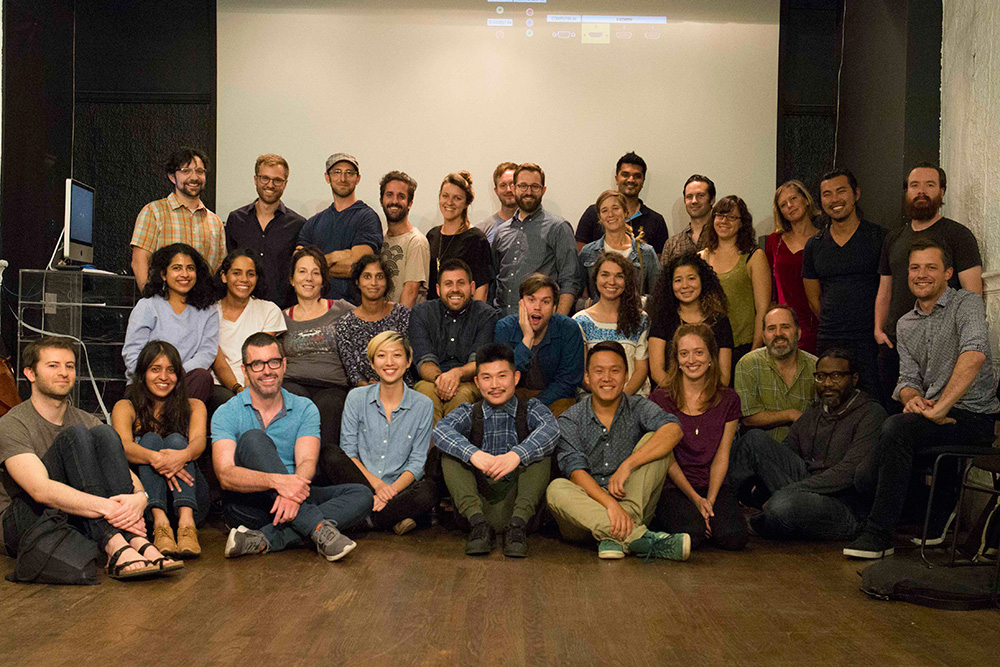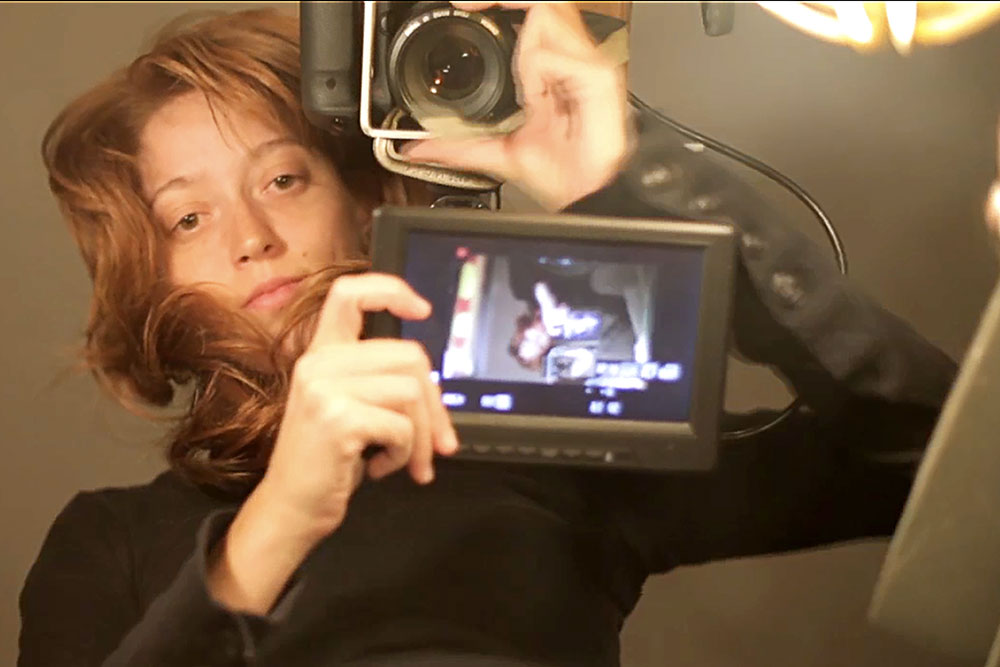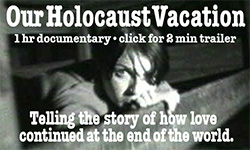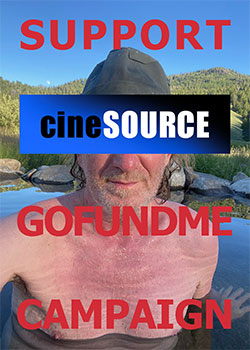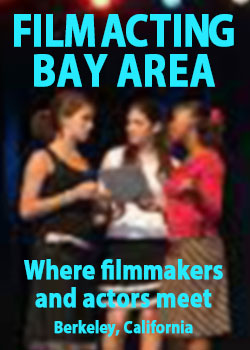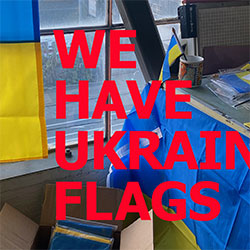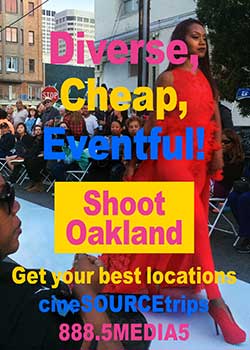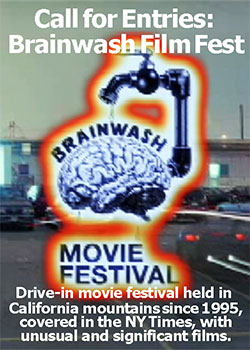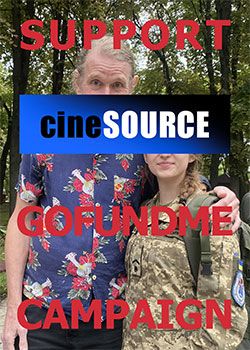Cine Collectives Come Back, Finally!
by Doniphan Blair
"MAKING FILMS IS CHALLENGING!"
the Brooklyn-based filmmaker Kai Beverly-Whittemore told me a few weeks ago by email. “Having colleagues who celebrate your victories, however big or small, is key.”
Indeed, Brooklyn has emerged as a hot bed of cooperative filmmaking, with the FilmShop, Meerkat Media and Ms. Beverly-Whittemore’s outfit, which includes veterans of the Sundance and South-By-South-West festivals, the Brooklyn Filmmakers Collective (BFC).
With the romantic reformation of the ‘60s came collectives and communes—the difference is worth noting: collectives share labor and costs, through vague or exact bookkeeping, while communes are like families with one bank account—and this movement included filmmakers who followed their blue-collar buddies into collectivizing.
Alas, cine collectives faded. When I did a web search a few years ago, there were only about a dozen and a half listed worldwide, many in India, where today they are no longer that popular, ironically.
In the West, however, cooperative cinema is coming back, and for good reason. Filmmaking obliges an almost exact balance between group and individual efforts, not to mention the truckloads of cash, making it essentially a socialist-capitalist hybrid.
Except for Robert Rodriguez, who “one-manned” his first film, “El Mariachi” (1993), or Jenni Olson, whose recent art feature, “Royal Road” (2015), consists only of people-less city-scapes, “All filmmaking requires collective making,” noted Beverly-Whittemore, “whether filmmakers chose to acknowledge that, that is the question.”
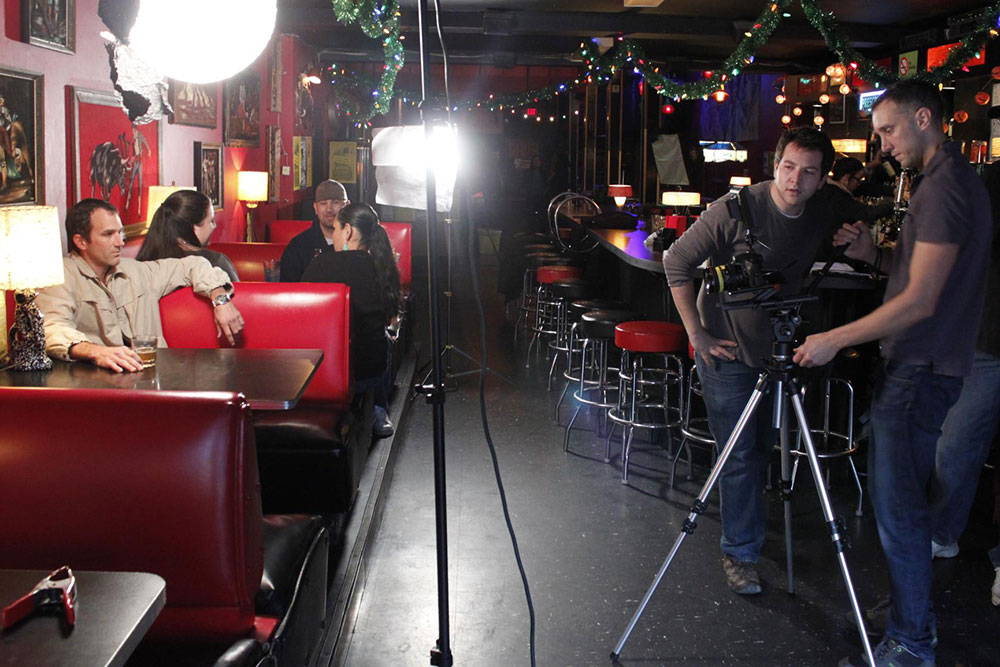 Olympia Film Collective shoots "Sweet Sorrow" at Olympia's Brotherhood Lounge: (lft-rt) Mac Proctor, talent, Riley Gibson, AC, and Dylan Glockler, DP. photo: courtesy OFCIndeed, even “Mariachi” needed actors, which Rodriguez dragooned from among his friends in San Antonio, Texas, and then ordered about in a directorial, domineering—dictatorial, some might even say—manner.
Olympia Film Collective shoots "Sweet Sorrow" at Olympia's Brotherhood Lounge: (lft-rt) Mac Proctor, talent, Riley Gibson, AC, and Dylan Glockler, DP. photo: courtesy OFCIndeed, even “Mariachi” needed actors, which Rodriguez dragooned from among his friends in San Antonio, Texas, and then ordered about in a directorial, domineering—dictatorial, some might even say—manner.
Hence the rub.
You need a team to produce a film, even a short one, but for that team to act together seamlessly on set, and for that film to hang together seamlessly on screen, you need artistic vision and unified direction—a captain.
Hence the "director”—called auteur in the ‘60s because, up until then, in the studio system, the real force behind a lot of pictures was the producer. Meanwhile, the writer is almost as important, sometimes writing a script so prophetic and precise that “it shoots itself.”
At any rate, no matter how domineering or dictatorial a Jean-Luc Godard or an Orson Welles could be, their films were viewed AND reviewed by others. This process starts the day of the shoot, with the crew watching the performances and then the daily rushes, and it continues with producers, friends and the public, in test screenings, where directors can either welcome or be force fed feedback—never easy, no matter how humble one may imagine they are.
“I was lucky to have had the experience of making art collectively throughout my childhood,” explained Beverly-Whittemore, who has worked in film on several continents and in the narrative and documentary form, and has directed her own films, notably the well-received short "Camera Obscura" (2010). “I first practiced filmmaking as a part of a student collective called Fire Escape Films at the University of Chicago.”
“After nearly a decade of making films in New York [commercially, including for clients like Gucci], I felt thirsty for a community of makers to challenge and enliven my work,” she continued. To achieve this, BFC follows a work flow common to collectives but which they have honed to perfection.
“We meet once a week to workshop a member’s work: a film, a script, a pitch or even an idea. With the help of a pre-determined moderator, we take turns speaking. BFC’s feedback system allows people to critique work honestly, without fear of damaging egos, or silencing our members.”
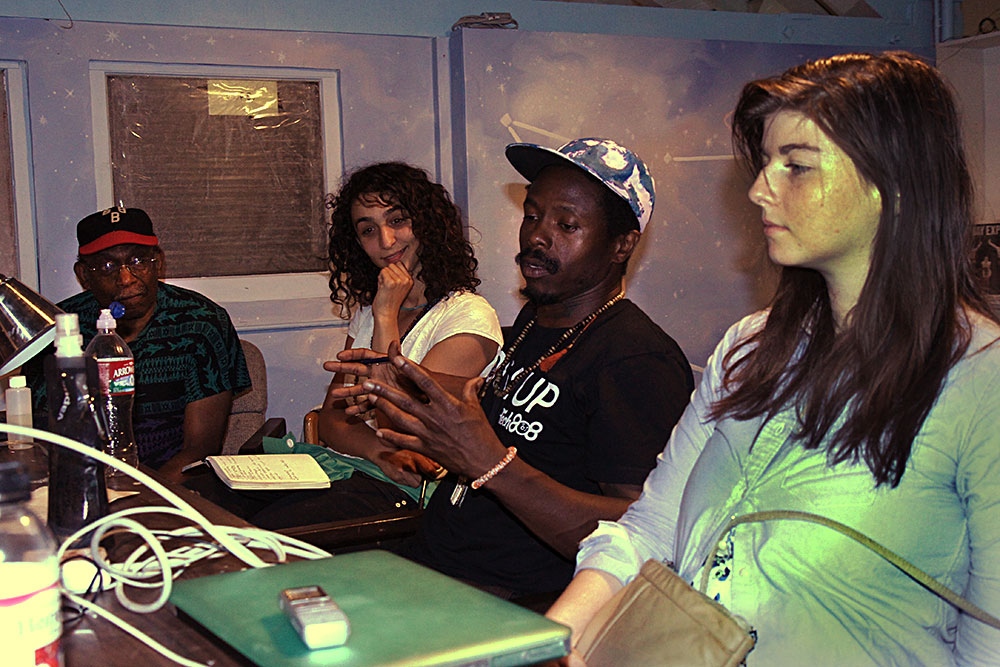 Members of Liberated Lens Collective listen to Dragon explaining their process at their weekly Tuesday meeting. photo: D. Blair“Afterwards, we usually hang out at a bar,” concluded Beverly-Whittemore, who is also a member of Film Fatales, a collective of women directors, cinematographers and producers with 60 members. “It’s a fun way to spend the night!”
Members of Liberated Lens Collective listen to Dragon explaining their process at their weekly Tuesday meeting. photo: D. Blair“Afterwards, we usually hang out at a bar,” concluded Beverly-Whittemore, who is also a member of Film Fatales, a collective of women directors, cinematographers and producers with 60 members. “It’s a fun way to spend the night!”
“I believe the reason that there are not that many collectives is we are Americans,” opined Gerald Smith, who was a Black Panther in his youth and is now part of the Oakland, California, group, which just changed its name from Opal Collective to Liberated Lens Collective (LLC). “We have this individualist thing. It is very difficult to build what I call ‘a league of equals.’”
“You look at unions—they are on decline. Independent grass root organizations that don’t get money from corporations have disappeared,” Smith continued. “America is different from other countries. In England they have a word for it—I saw when I was there—‘Is he a joiner?’ Does he maintain professional affiliations.”
According to the LLC website, they share ”resources, skills and knowledge to tell stories that might otherwise remain untold.” Eschewing expensive film school, although some have attended, they learn by teaching each other and they work “horizontally” and “by consensus,” ie super-majority, not mere democracy.
Started last year with limited resources, LLC has finished or is finishing a half-a-dozen films, notably the Youtube short, “The Murder of Pedie Perez”, a three-minute short cut from a liquor store surveillance video and interviews with witnesses, and ‘Seeds of Struggle’, about black farmers, food deserts and emerging farmer markets. They recently held their first annual F2P—Films 2 The People Short Film Festival.
“There used to be collectives in the ‘70s and some of them became mainstream institutions,” chimed in Dennis Terry, who brought ‘Seeds of Struggle’ to the collective. Our interview was conducted collectively at one of their Tuesday night meetings at The Omni, a large community building in North Oakland that hosts many collectives and art groups.
“The Bay Area Video Coalition,” a low-cost. local provider of classes and equipment, “used to be called the Bay Area Video Collective,” Terry pointed out. “If some of those groups were still around, there would be more collectives.”
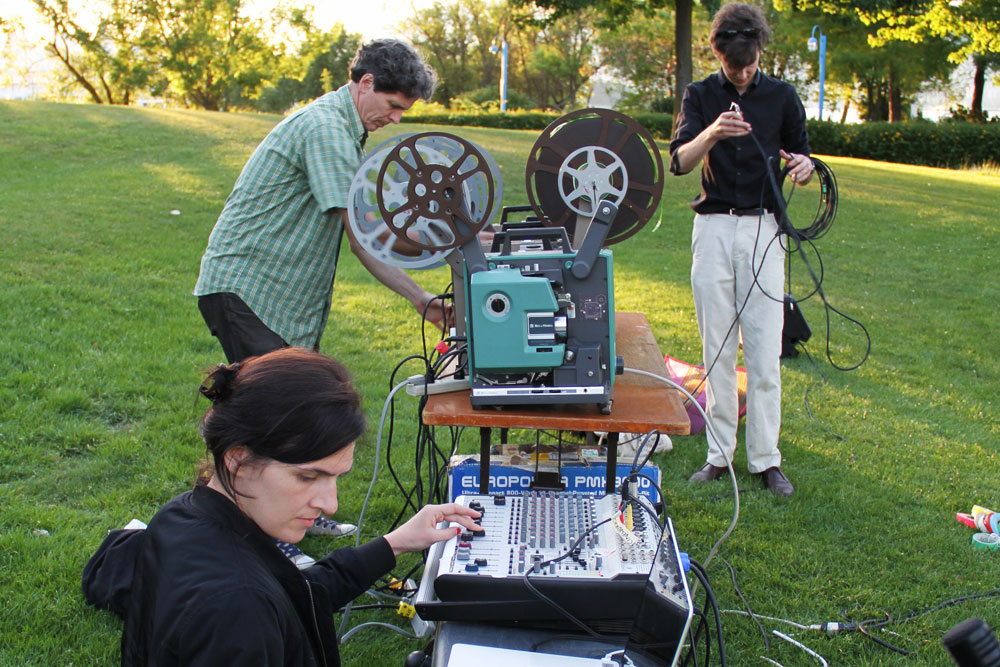 Vancouver's Iris Collective sets up to show actual acetate, one of their specialties. photo: courtesy Iris CollectiveTo my query about conflict resolution, Dragon, a young black man with tattoos, explained: “In the end, it is all about who has the most endurance to wrestle with an idea. The rest of us will give up: ‘It is 12 midnight, I am going home.’”
Vancouver's Iris Collective sets up to show actual acetate, one of their specialties. photo: courtesy Iris CollectiveTo my query about conflict resolution, Dragon, a young black man with tattoos, explained: “In the end, it is all about who has the most endurance to wrestle with an idea. The rest of us will give up: ‘It is 12 midnight, I am going home.’”
“We don’t have rules” shouted someone from the back but Anka, a young woman with an accent as well as multiple tattoos, seconded Dragon: “If you do the work, you get to make the decisions.” LLC also has two members who are professional cinematographers but, tellingly, don’t often attend meetings.
Despite Dennis Terry’s concerns, even if there are not that many film collectives today, there is an incredible variety.
On one hand, New Day, a distributor formed in 1973 “to help the women's movement grow," according to co-founder Julia Reichert, is still going strong. On the other, there are the Hollywood wonderkinds, Blue-Tongue Films, six 30- or 40-something Australians, plus one American.
Founded in 1996, around the making of a B/W car chase short, Blue-Tongue Films— an Aussie inside joke, evidently, since bluetongue is a disease effecting sheep —appears to have been built largely around the Edgerton brothers.
Nash was already doing television bit parts when he created and starred in the car chase short, which was booed at its first screening for being too Hollywood. But he and his brother and buddies soon made “Deadline”, expanding the car-chase conceit into a race to submit a film to a film festival. They also started showing everyone exactly how “too Hollywood” they could be.
Nash’s brother, Joel, who attended acting school, soon became a Hollywood actor with “Star Wars Episode II: Attack of the Clones” (2002), then starred in the English-American comedy “Kinky Boots” (2005). More recently he has appeared in “Zero Dark Thirty” (2012, which also included Nash) and “The Great Gatsby” (2013, directed by the Aussie Baz Luhrmann).
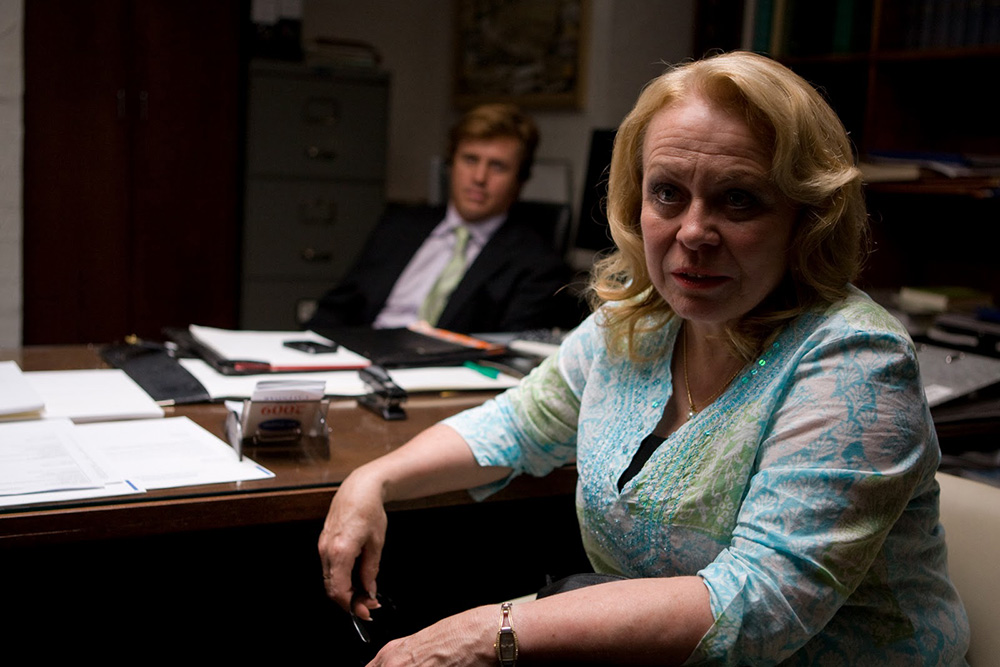 'Animal Kingdom''s Jacki Weaver—the godmother of a crime family in this Blue-Tongue production—was nominated for a Golden Globe Best Supporting Actress Award. photo: courtesy Blue-TongueBy that point, the Blue-Tongue Collective had become an international film phenom, due to their Oscar-nominated “Animal Kingdom” (2010), see trailer, directed by their most prolific director/writer, David Michôd, again starring Joel but also the memorable Guy Pierce (“Memento”, 2000, “King’s Speech”, 2013, etc), who happens to be English-Australian.
'Animal Kingdom''s Jacki Weaver—the godmother of a crime family in this Blue-Tongue production—was nominated for a Golden Globe Best Supporting Actress Award. photo: courtesy Blue-TongueBy that point, the Blue-Tongue Collective had become an international film phenom, due to their Oscar-nominated “Animal Kingdom” (2010), see trailer, directed by their most prolific director/writer, David Michôd, again starring Joel but also the memorable Guy Pierce (“Memento”, 2000, “King’s Speech”, 2013, etc), who happens to be English-Australian.
Inspired by Melbourne’s Pettingill crime family, “Animal Kingdom” is a mafia story with a twist—as there are in many Blue-Tongue films. In this case, the heavy is the family’s matriarch, played by Jacki Weaver.
Although Blue-Tongue relies on thriller, noir and horror tropes, as well as Hollywood production values, they soon graduated to investigating and skewering modern and hip—indeed, their very own—lifestyles and culture.
“Wish You Were Here” (2012), the debut feature by longtime member Kieran Darcy-Smith, and starring his wife Felicity Price (who co-wrote it with him) as well as Edgerton, is a stylish story with lovely “shallow focus” photography. Starting with a fun-filled frolic in South-East Asia, it leaps into drugs, infidelity, disappearance and death, all fulcrumed around a momentary indiscretion.
In fact, just last month, Edgerton completed—almost singlehandedly, given he directed, wrote AND co-starred, but with lots of help from the collective—the critically acclaimed “The Gift“ (2015), see trailer, starring Jason Bateman and Rebecca Hall. It follows a happy, middleclass couple who encounter a character from the husband’s past (played by Edgerton) and are ripped asunder.
“Underneath it all, ‘The Gift’ is a merciless critique of an amoral corporate culture in which the ends justify the means,” wrote reviewer Stephen Holden in the NY Times (8/6/2015).
Ridiculously prolific, Blue-Tongue’s seven features also include “The Rover” (2014), Michôd and Pearce again; “Felony” (2013), directed by Matthew Saville but written by and starring the ever-hardworking Joel; and “The Square” (2010) directed by brother Nash but again starring and written by Joel (with co-writer Matthew Dabner).
Moreover, they have made dozens of shorts and music videos for the likes of Bob Dylan, Lana Del Rey (two of this author’s faves) and Eskimo Joe.
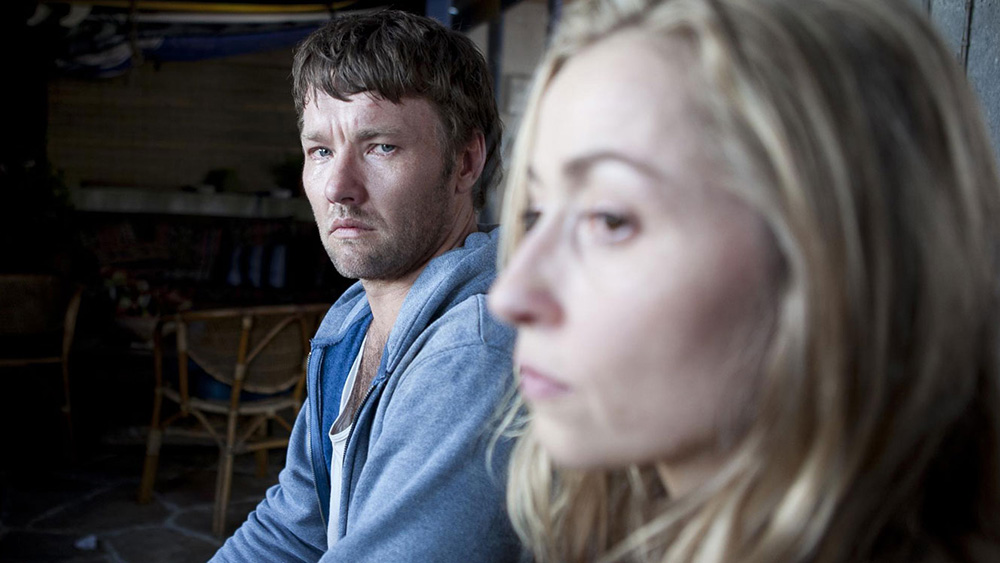 Things are not looking good for Joel Edgerton's character after he slept with his wife's sister in the Blue-Tongue collective's 'Wish You Were Here' (2012). photo: courtesy Blue-TongueObviously busy, a Blue-Tongue member didn’t get back to CineSource on how collective they actually are or how they resolve conflicts—but they obviously do, and do so quickly. Certainly, if they are a full collective, they are the movement’s poster child, for their prodigious output, their Hollywood achievement and their use of subversive stories within established genres. They apparently also remain grassroots activists.
Things are not looking good for Joel Edgerton's character after he slept with his wife's sister in the Blue-Tongue collective's 'Wish You Were Here' (2012). photo: courtesy Blue-TongueObviously busy, a Blue-Tongue member didn’t get back to CineSource on how collective they actually are or how they resolve conflicts—but they obviously do, and do so quickly. Certainly, if they are a full collective, they are the movement’s poster child, for their prodigious output, their Hollywood achievement and their use of subversive stories within established genres. They apparently also remain grassroots activists.
“Joel has been an ‘ambassador’ for the Fred Hollows Foundation,” named for a dedicated Australian doctor, “which works to restore people's sight in poor countries and to improve Aboriginal health,” according to Wikipedia, which quotes Edgerton saying it is “an escape” from the “materialistic life” acting often involves.
And Blue-Tongue is not the only collective to crack the commercial cinema market.
In the late ‘70s, the Bay Area group, Cine Manifest, put together its first big project, the narrative “Northern Lights”, a B/W feature about workers trying to organize during a rough North Dakota winter. To the surprise of many, it took Cannes’ Caméra d'Or in 1980 and showed worldwide.
“Northern Lights” co-director Rob Nilsson, now 74 and living in Berkeley, remains a renown filmmaker locally and internationally. His Citizen Cinema has produced almost twenty features, narrative and doc, the former using a style of improvised filmmaking he calls “direct action” and which derives in part from his mentor, John Cassavetes.
His new film, “Permission to Touch”, world premiering at the Mill Valley Film Festival which starts on October 9th, reprises his role as the photojournalist Mel Hurle from “Heat and Sunlight”, his 1987 Sundance Grand Jury winner. Nilsson is also an old friend of this author.
“Cine Manifest was a true communal collective, if you want to call it that,” he told me recently, suggesting they were more a family than a strict bookkeeping collective, “from each according to their abilities and to each according to their needs.”
“We divvied salaries exactly—those who made salaries. Those who didn’t, received back and contributed in other ways, the development of scripts, other activities. We had a whole organization of duties, including babysitting, in a warehouse down on 11th and Folsom [in San Francisco], next to a gay bar called CBs.”
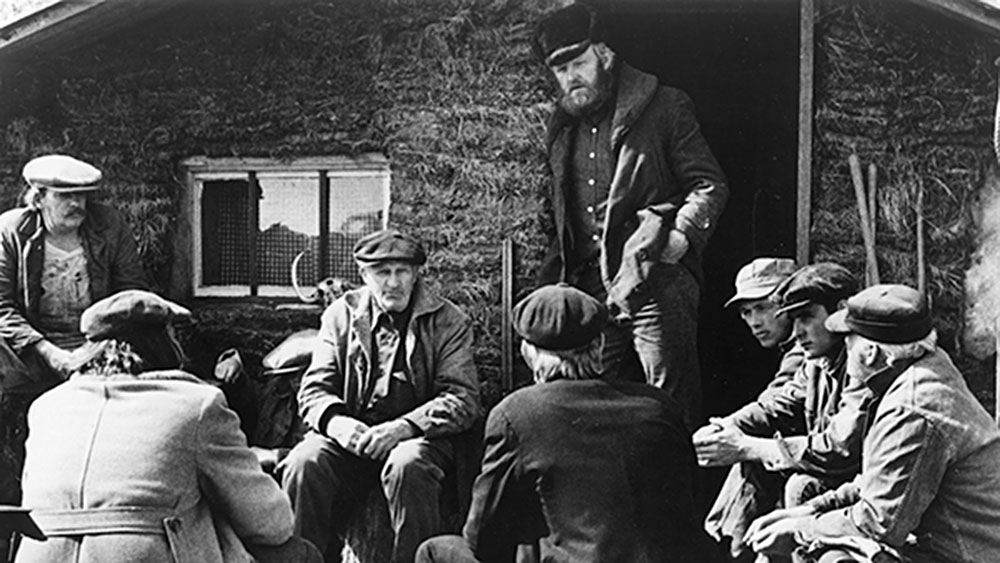 A scene from Cine Manifest's 'Northern Lights', a unionizing meeting in a freezing sod house, shot on location in North Dakota with many collective members acting. photo: courtesy Cine Manifest“We didn’t have a grip truck but Dana Fuller had one parked at our warehouse. It would be rented, as would our editing rooms. We had three Steinbeck [editing flatbeds]. We cut ‘Northern Lights’ there and three documentaries related to ‘Northern Lights’, prairie populism and the nonpartisan issue.”
A scene from Cine Manifest's 'Northern Lights', a unionizing meeting in a freezing sod house, shot on location in North Dakota with many collective members acting. photo: courtesy Cine Manifest“We didn’t have a grip truck but Dana Fuller had one parked at our warehouse. It would be rented, as would our editing rooms. We had three Steinbeck [editing flatbeds]. We cut ‘Northern Lights’ there and three documentaries related to ‘Northern Lights’, prairie populism and the nonpartisan issue.”
“The idea was originally John’s,” John Hanson, Nilsson’s co-director, "but we collaborated on all the writing, directing and editing—even now we are collaborating. We recently did a 20-city tour with the film [2014].”
“We talked everything over—endless discussions. We wrote papers about it; we studied leftist cinema operations like Cinema Novo [in Brazil], the French New Wave, the guys at Neo-Realism [in Italy].”
“We were aware that you had to have functions, so we assigned functions according to the best of our abilities. If you were chosen as the director, you directed; the shooter, you shot. We didn’t fall into that trap of [worrying about the director] having too much power. If we didn’t like the way the functions were going, we made changes.”
“There is a huge book somewhere of the all the notes we were writing to each other,” Nilsson said, laughing.
“There were many smart people. Some, like John and myself, were more populist; some claimed to be Marxist but how much they knew about Marxism I don’t remember. We didn’t get stuck in ideology, thank god for that!” he recalled, with an even bigger laugh.
“You have to allow for a diverse set of views,” was Nilsson’s advice to newly forming collectives.
“You need to look for the skills in the room—who is really good at what? And you need to have distinct roles that can be reviewed. You submit where submission makes sense—someone has a better take that you—but, when you have bottom line values, you hold tight, although you might have to adjust somewhat.”
“That is why we studied those others groups, to try to see how they solved the problems of being passionate and, at the same, collective,” added Nilsson, who parlayed his collective experience into the Tenderloin Group, which made ten "9 at Night" films over the years, using a diverse team, ranging from professionals to homeless.
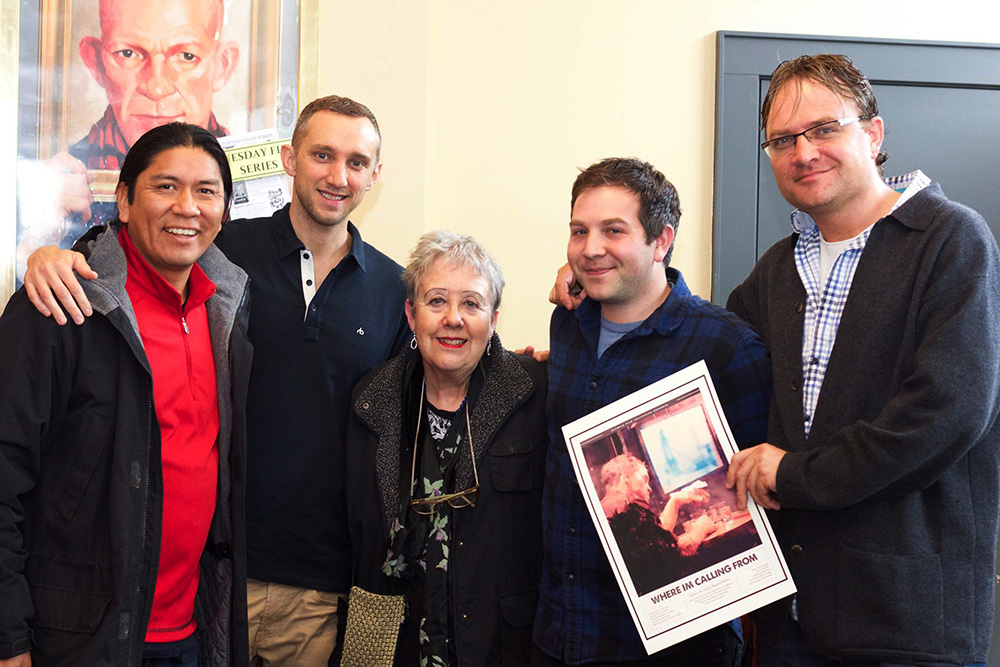 Olympia Film Collective meets with Tess Gallagher, widow of Raymond Carver, author of 'Where I'm Calling From', from which Riley Gibson (2nd from right) shot a film of the same name (Jeff Barehand, 2nd from left). ‘It was more of a workshop. We made films in a collective way, you could say, but it was not organized like a collective. You went home at night and were your own person.”
Olympia Film Collective meets with Tess Gallagher, widow of Raymond Carver, author of 'Where I'm Calling From', from which Riley Gibson (2nd from right) shot a film of the same name (Jeff Barehand, 2nd from left). ‘It was more of a workshop. We made films in a collective way, you could say, but it was not organized like a collective. You went home at night and were your own person.”
“One of the most difficult problems is to move a project forward,“ noted Riley Gibson of the Olympia Film Collective (OPC), in Washington State, when I put the problem-solving question to him and his colleague Jeff Barehand, also on the phone.
“It is easy in meetings to talk about films but harder in reality. The person who spearheads it becomes the ‘secretary’ for the film,” Gibson explained. Essentially the producer, “they put it on the calendar and manage it. There may be different directors, DPs, gaffers.”
“Everyone says ‘Write what you know,’” mused Barehand, who is First Nation, albeit from Maryland not the North-West. “I say, ‘Write a story that you have access to film.’ So I write about people I know and most of those people are white.” Still, OPC members are dedicated activists, mostly around getting media services to Native Americans.
“In Tacoma, we are surrounded by three tribes,” Barehand elaborated. “We did a film camp for the Nisqually [tribe]. Riley [Gibson] and I did Sky Bear Media to make corporate and nonprofit videos—the tribes will only work with established businesses—and through those we hire OFC members.”
“We are trying to make OPC a non-profit and use their kids to crew films,” added Barehand, who also sits on the board of a First Nation theater company in Seattle. In addition, “We are making a mini-doc about a hieroglyphic-covered rock of the Colville tribe that tells their oral myths.”
“For me, it is all about defining goals and a mission statement,” I was informed by Lanre Olabisi of the New York Independent Film Collective (NYIFC), “so everyone can be on board and be on the same page.”
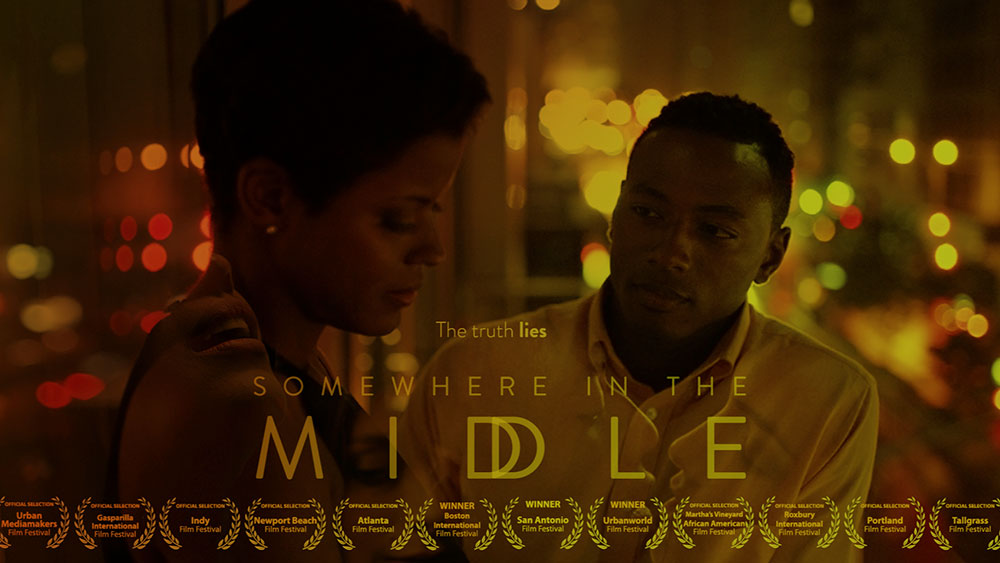 A rich, moody image greets you on the site of the New York Film Collective's feature, 'Somewhere in the Middle', now winning numerous awards on the festival circuit. photo: courtesy L. Olabisi. In fact, NYIFC has a very ambitious mission statement: “We are committed to creating a film a year, a film that really explores diversity and different aspects of society, that is thought-provoking and boundary-pushing, in some way.”
A rich, moody image greets you on the site of the New York Film Collective's feature, 'Somewhere in the Middle', now winning numerous awards on the festival circuit. photo: courtesy L. Olabisi. In fact, NYIFC has a very ambitious mission statement: “We are committed to creating a film a year, a film that really explores diversity and different aspects of society, that is thought-provoking and boundary-pushing, in some way.”
“I attended City College film school, the smallest in New York, with 40 something students,” continued Olabisi, whose father is Nigerian. “In 2012, I started ‘Somewhere in the Middle’, a 90-minute feature.” It follows four lovers, as one marriage morphs into several intertwining affairs, and premiered at the Atlanta Film Festival, and “is doing the festival circuit as we speak.”
“We all worked on [‘Somewhere’] in some capacity, although we had to hire out for some crew. We co-created the script through one year of improvisation and raised $105,000. We REALLY wanted to create a film!” enthused Olabisi. “I don’t know how much of a formalized thing we do except meeting up and creating the script. I was the only director so, naturally, I became the director.”
“A few of us had Meisner training, which [imbued] a certain style for the collective,” he added. Developed by Sanford Meisner in New York in the ‘60s, it rejects method acting’s “emotional recall” for getting the actor "out of their heads" and into their gut, instinctual feelings.
Taking a different route, Vancouver’s Iris Film Collective, started with a film challenge from the art/music festival Art Waste. “We shared these pieces at the Cineworks Annex [an artist-run space in Vancouver],” recalled Lisa g. Nielsen, a member. “A relationship seemed to really gel.”
“Seeing things that the other members do, inspires me to take more chances,” she said. “We screen to a broad range of folks. Our aim is to pull people into the love of film,” which she means literally.
“We challenged ourselves to create fully analog shorts using ORWO 16mm print stock, both for shooting and the print. The ASA was 6, so you needed LOTS of light, but you could have a safelight on when you develop and make the print. It is also an economical way to go since this film is relatively inexpensive.”
 'The Dewarists' zooms in on bassist Susheela Raman of the band Indian Ocean. photo: courtesy DewaristsGiven they live in the more socially-conscious Canada, Vancouver provides them a studio in an old caretaker’s field house. In addition to holding screenings and workshops there, Iris’ eight members and various associates built a full darkroom, where they process 16mm film and strike prints—incredible in today’s digital age.
'The Dewarists' zooms in on bassist Susheela Raman of the band Indian Ocean. photo: courtesy DewaristsGiven they live in the more socially-conscious Canada, Vancouver provides them a studio in an old caretaker’s field house. In addition to holding screenings and workshops there, Iris’ eight members and various associates built a full darkroom, where they process 16mm film and strike prints—incredible in today’s digital age.
Although they work in the same space, share techniques and work collectively on presentation (design of posters and merch, social media, grant writing), they haven't made a film collectively yet. “We have complete creative control over our own individual films,” noted lisa g, as she prefers her professional name to be written. They recently hosted the Windows Collective from Ottawa, including a screening and sold-out workshop.
Given Gerald Smith’s comment about American individualism, you would expect to find more collectives overseas and no where more so than India, which has a history of socialism.
Ironically, of late, Indians have been turning to capitalism and high tech, as reflected in the 120 Media Collective, which focuses on commercials and marketing, despite its name. The United States also has The Media Collective, a Nashville advertising agency, albeit helmed by the obviously interesting Velvet Rousseau Kelm and working almost entirely with musicians.
There are still Indian collectives, like the People's P.o.w.e.r. Collective, which would undoubtedly earn Smith’s approval for name alone, although their docs, “Fish Tales”, about their own development, and another on empowering rural communities through radio, sound very interesting.
The New Delhi-based Jamun Collective emerged out of the team that made “The Dewarists”, a TV travelogue and music show about some of India's finest musicians. They believe in “embracing new tools of creation, while preserving the romance of filmmaking,” according to their site. “Our body of work is diverse, including socially-engaged advocacy, music videos, brand films and," tipping their hat to India’s new zeitgeist, "advertising but we are keen to explore other forms.”
Africa is where we find the most film cinema collectives, starting with the Mosireen Collective, which sprang out of the citizen journalism of Egypt’s “Arab Spring” revolution of 2011. Then there's Slum TV, which brings media access to impoverished Kenyan communities; Chop Cassava, a web doc team from Nigeria covering demonstrations and alternative views; and the Otolith Group carrying on the spirit of England’s pioneering Black Audio Film Collective (BAFC).
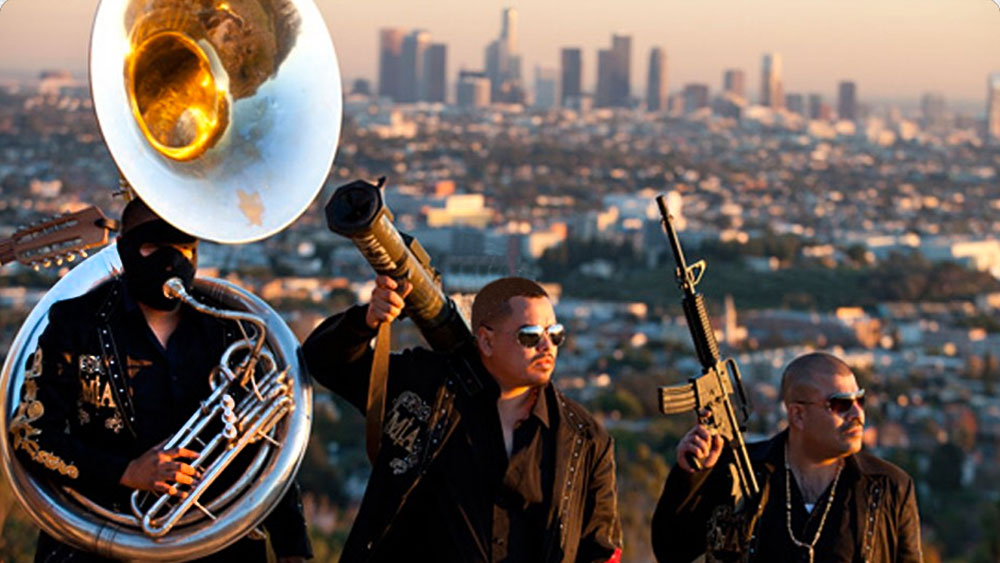 Meerkat Media's doc feature 'Narco Cultura' tackles the provocative mix of music and murder in Juarez, Mexico, even though they are based 2000 miles away in Brooklyn. photo: courtesy Merkat Media Founded in 1982 and comprised of black British and diaspora artists and filmmakers, BAFC closed in 1998 but its work still tours and its ideas still resonate.
Meerkat Media's doc feature 'Narco Cultura' tackles the provocative mix of music and murder in Juarez, Mexico, even though they are based 2000 miles away in Brooklyn. photo: courtesy Merkat Media Founded in 1982 and comprised of black British and diaspora artists and filmmakers, BAFC closed in 1998 but its work still tours and its ideas still resonate.
Indeed, in London is the hardworking Kitchen Sink Films, an international crew of almost ten, with a notable Eastern European and Asian presence, and one the few collectives in my research to concentrate almost entirely on documentaries, which used to be a collective specialty.
Their recent films include “Elephant’s Dream”, a “poetic documentary” about the Congo’s return to normalcy after the devastating civil war; “Ecocide” (2014) , about an island community dealing with environmental disaster; and “A Letter to Dad” (2009) a look back at Yugoslavia, from when the filmmaker’s parents fell in love to the terrible Balkan wars of the ‘90s which killed his father.
Across the Channel, the Kran Film Collective, with offices in Brussels and Copenhagen, helps more artistic films crack the commercial market. They also do filmmaker residencies, programs with local venues and host films on their site, including the iconoclastic selections “Eden”, revisiting the book of Genesis, and “Sacred Time", about the execution of Emperor Maximilian in 19th century Mexico.
Also focusing almost exclusively on social documentaries is ZaLab, out of Italy, which even has social workers on their squad. Their award-winning television docs feature great titles like "Limbo", "Closed Sea” and "Green Blood." As part of their activism, they do video workshops in places like the West Bank or the slums of Barcelona.
Back in Brooklyn, along with the BFC, there’s Meerkat Media which works in various genres, from the fantastic-looking doc feature “Narco Cultura” (premiered at Sundance in 2014) which highlights the massive murder rate AND music halls of Juarez, Mexico, to “Brasslands” (2013), about a small Serbian village with an enormous music festival. They also do experimental films.
Meanwhile, the FilmShop, which actually has chapters in both Brooklyn and Manhattan, meets weekly to workshop projects and make shorts for their periodic themed screenings.
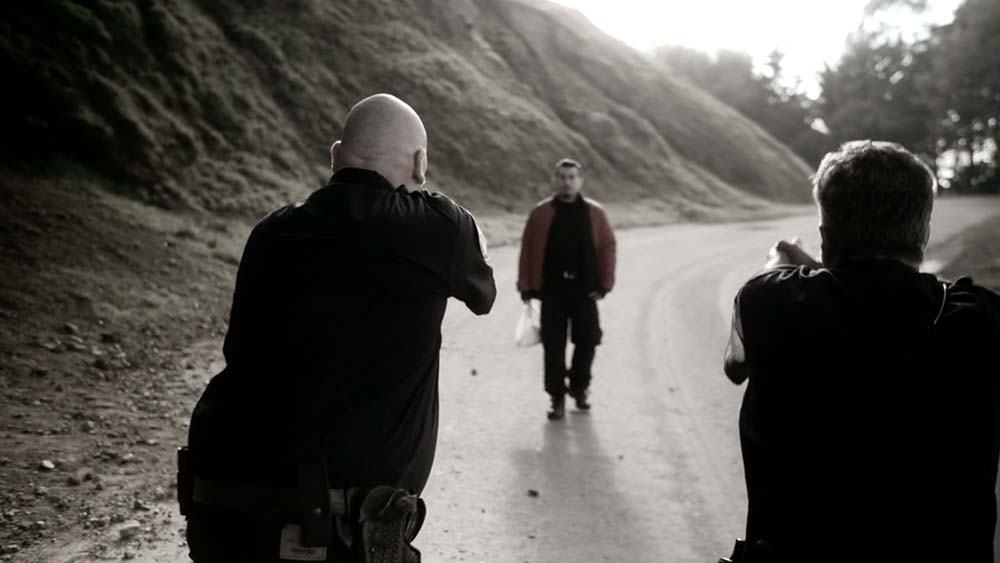 Scene from Green Eyed Media's 'Amor for Alex', directed by Rafael Flores and their contribution to the Brown Lives Matter movement. photo: courtesy R. Flores Around the country, the Parallel Film Collective in Washington, D.C. is dedicated to countering mainstream media’s racial and gender tropes while in the belly of the stereotypical beast, Hollywood, the Los Angeles Film Collective recently got rolling and is producing many shorts. “We always need actors,” says their site.
Scene from Green Eyed Media's 'Amor for Alex', directed by Rafael Flores and their contribution to the Brown Lives Matter movement. photo: courtesy R. Flores Around the country, the Parallel Film Collective in Washington, D.C. is dedicated to countering mainstream media’s racial and gender tropes while in the belly of the stereotypical beast, Hollywood, the Los Angeles Film Collective recently got rolling and is producing many shorts. “We always need actors,” says their site.
More professional and production-oriented is Chicago’s Film Collective Productions, directed by Vincent Singleton, which might mean it not an “official” collective but check out their site for their multiethnic tour de force compilation of narratives, docs, commercials and music videos. Similarly, Camp 4 Collective, an intense team of outdoor filmmakers who met making commercials for Northface, have a hell of a trailer.
Oakland’s Green Eyed Media is another semi-collective association of working professionals. Nominally run by Rafael Flores, they have chapters in Seattle, Los Angeles and elsewhere on the coast, and make everything from music videos to powerful, political shorts like "Amor for Alex", about last year's San Francisco police killing of Alex Nieto in a heavily-gentrified neighborhood. Flores is also a provocative theorist, notably of "Cinema of the Poor", see his "Towards a Rasquache Cinema: Chicano 3rd Cinema", or this CineSource article.
Then there’s Collective Friction, another pro-team out of Toronto; the AgX Film Collective, a newly established group in an old Massachusetts textile mill which does actual celluloid and rotoscoping; the Film 9 Collective, of indeterminate location (perhaps Raleigh, NC), which also labors to preserve celluloid and publishes the mag F/9; the Atlanta Film Festival Collective, which has an on-demand program of shorts from festivals around the East; and the Seattle Filmmakers Collective, mostly an information center, apparently, but undoubtedly critical to Seattle's slowly emerging film scene.
As laudable and useful as collective filmmaking certainly is, it can also be hard work, as I can testify from my own experiences trying to make a feature 16mm film with Ancient Currents Gallery, a collective, and the Modern Lovers, a commune, which were both located in a storefront on Pine Street in San Francisco, from 1975 to 1986.
“Best drug film I have ever seen,” remarked George Kuchar, the alt-filmmaker and teacher, after seeing a rough cut we showed at the San Francisco Art Institute in 1977.
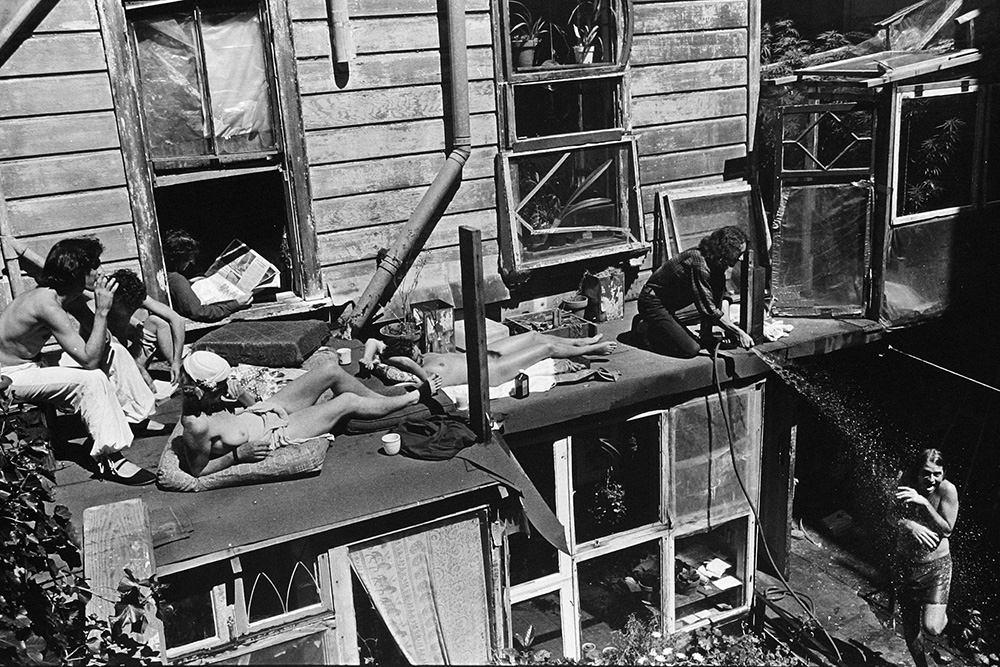 Members of the Modern Lovers Commune relaxing (or was it working) in their backyard on Pine Street in San Francisco, circa 1980. photo: N. Blair “Sammy Delerium” concerned a filmmaker (yours truly), making a film about how to obtain inspiration (hence the title, we favored spelling it “delerium,” for the double “e” graphic look) but who gets caught up in the complexities of low-budget filmmaking—disappearing actors, drug use, dissolving story lines.
Members of the Modern Lovers Commune relaxing (or was it working) in their backyard on Pine Street in San Francisco, circa 1980. photo: N. Blair “Sammy Delerium” concerned a filmmaker (yours truly), making a film about how to obtain inspiration (hence the title, we favored spelling it “delerium,” for the double “e” graphic look) but who gets caught up in the complexities of low-budget filmmaking—disappearing actors, drug use, dissolving story lines.
Although commune members tolerated being dragooned into acting and crewing—notably my brother, Nicholas Blair, who played the dealer financing the film and bravely staggered out naked and stoned into a party full of people—mostly, they weren’t that thrilled. Admittedly, I might have been a tad domineering, dictatorial even, on occasion, while they were not trained actors or even film or drama students.
My attempts to fire them up—by explaining that the film predated the commune (I chose the building where we were located because of its many great sets), or that the free housing, organic food and superior drugs they were enjoying (rather prodigiously!) were in-trade for occasional work on the film, the art gallery and other art projects—didn’t fly.
“This film is all just for you,” they would tell me, laughing, between tokes, “so that you can get famous. The commune will never get anything out of it. But keep working on it if you like. Just don’t forget to do your share of the chores!”
When my all-night edit sessions interrupted dish duties and the criticisms escalated, I came to feel that finishing “Sammy Delerium” might finish me. Why I didn’t place ads on job boards at local film schools for actors and crew, I don’t know. Perhaps I was trying to rebuild the "art family" I felt I had lost.
At any rate, I learned a lot. I heartily agree with Lanre Olabisi's suggestion about defined goals, perhaps even a contract of sorts saying, “This is what you are expected to give; this is what you will receive.” Nilsson's recommendation, to have distinct roles that can be reviewed and, if need be, changed, is also essential.
In general, it is best to eschew communes, as attractive as their family feelings might be, due to their more emotional nature. Go for a well-ordered collective or a “capital-mune”, where you simply pay people, perhaps only a symbolic amount but with more promised (contractually) after any success, and enough to inspire them to show up and work.
Whatever the arrangement, outline it clearly on paper, allow ample options for adjustment, notably how to join or exit the fraternity, and have a “pre-determined moderator,” like the Brooklyn Filmmakers Collective. Then you will be all set to rock and roll, roll tape or zap flash drives, as the case may be.
Indeed, as the above examples amply illustrate, a functional collective is the perfect antidote to the problems plaguing contemporary cinema, both in terms of production but also, as Blue-Tongue's Joel Edgerton noted, to the capitalist values that can seep in from the medium's working conditions and requirements.
Doniphan Blair is a writer, film magazine publisher, designer and filmmaker ('Our Holocaust Vacation'), who can be reached .
Posted on Oct 09, 2015 - 01:59 AM
by Doniphan Blair
"MAKING FILMS IS CHALLENGING!"
the Brooklyn-based filmmaker Kai Beverly-Whittemore told me a few weeks ago by email. “Having colleagues who celebrate your victories, however big or small, is key.”
Indeed, Brooklyn has emerged as a hot bed of cooperative filmmaking, with the FilmShop, Meerkat Media and Ms. Beverly-Whittemore’s outfit, which includes veterans of the Sundance and South-By-South-West festivals, the Brooklyn Filmmakers Collective (BFC).
With the romantic reformation of the ‘60s came collectives and communes—the difference is worth noting: collectives share labor and costs, through vague or exact bookkeeping, while communes are like families with one bank account—and this movement included filmmakers who followed their blue-collar buddies into collectivizing.
Alas, cine collectives faded. When I did a web search a few years ago, there were only about a dozen and a half listed worldwide, many in India, where today they are no longer that popular, ironically.
In the West, however, cooperative cinema is coming back, and for good reason. Filmmaking obliges an almost exact balance between group and individual efforts, not to mention the truckloads of cash, making it essentially a socialist-capitalist hybrid.
Except for Robert Rodriguez, who “one-manned” his first film, “El Mariachi” (1993), or Jenni Olson, whose recent art feature, “Royal Road” (2015), consists only of people-less city-scapes, “All filmmaking requires collective making,” noted Beverly-Whittemore, “whether filmmakers chose to acknowledge that, that is the question.”
 Olympia Film Collective shoots "Sweet Sorrow" at Olympia's Brotherhood Lounge: (lft-rt) Mac Proctor, talent, Riley Gibson, AC, and Dylan Glockler, DP. photo: courtesy OFC
Olympia Film Collective shoots "Sweet Sorrow" at Olympia's Brotherhood Lounge: (lft-rt) Mac Proctor, talent, Riley Gibson, AC, and Dylan Glockler, DP. photo: courtesy OFCHence the rub.
You need a team to produce a film, even a short one, but for that team to act together seamlessly on set, and for that film to hang together seamlessly on screen, you need artistic vision and unified direction—a captain.
Hence the "director”—called auteur in the ‘60s because, up until then, in the studio system, the real force behind a lot of pictures was the producer. Meanwhile, the writer is almost as important, sometimes writing a script so prophetic and precise that “it shoots itself.”
At any rate, no matter how domineering or dictatorial a Jean-Luc Godard or an Orson Welles could be, their films were viewed AND reviewed by others. This process starts the day of the shoot, with the crew watching the performances and then the daily rushes, and it continues with producers, friends and the public, in test screenings, where directors can either welcome or be force fed feedback—never easy, no matter how humble one may imagine they are.
“I was lucky to have had the experience of making art collectively throughout my childhood,” explained Beverly-Whittemore, who has worked in film on several continents and in the narrative and documentary form, and has directed her own films, notably the well-received short "Camera Obscura" (2010). “I first practiced filmmaking as a part of a student collective called Fire Escape Films at the University of Chicago.”
“After nearly a decade of making films in New York [commercially, including for clients like Gucci], I felt thirsty for a community of makers to challenge and enliven my work,” she continued. To achieve this, BFC follows a work flow common to collectives but which they have honed to perfection.
“We meet once a week to workshop a member’s work: a film, a script, a pitch or even an idea. With the help of a pre-determined moderator, we take turns speaking. BFC’s feedback system allows people to critique work honestly, without fear of damaging egos, or silencing our members.”
 Members of Liberated Lens Collective listen to Dragon explaining their process at their weekly Tuesday meeting. photo: D. Blair
Members of Liberated Lens Collective listen to Dragon explaining their process at their weekly Tuesday meeting. photo: D. Blair“I believe the reason that there are not that many collectives is we are Americans,” opined Gerald Smith, who was a Black Panther in his youth and is now part of the Oakland, California, group, which just changed its name from Opal Collective to Liberated Lens Collective (LLC). “We have this individualist thing. It is very difficult to build what I call ‘a league of equals.’”
“You look at unions—they are on decline. Independent grass root organizations that don’t get money from corporations have disappeared,” Smith continued. “America is different from other countries. In England they have a word for it—I saw when I was there—‘Is he a joiner?’ Does he maintain professional affiliations.”
According to the LLC website, they share ”resources, skills and knowledge to tell stories that might otherwise remain untold.” Eschewing expensive film school, although some have attended, they learn by teaching each other and they work “horizontally” and “by consensus,” ie super-majority, not mere democracy.
Started last year with limited resources, LLC has finished or is finishing a half-a-dozen films, notably the Youtube short, “The Murder of Pedie Perez”, a three-minute short cut from a liquor store surveillance video and interviews with witnesses, and ‘Seeds of Struggle’, about black farmers, food deserts and emerging farmer markets. They recently held their first annual F2P—Films 2 The People Short Film Festival.
“There used to be collectives in the ‘70s and some of them became mainstream institutions,” chimed in Dennis Terry, who brought ‘Seeds of Struggle’ to the collective. Our interview was conducted collectively at one of their Tuesday night meetings at The Omni, a large community building in North Oakland that hosts many collectives and art groups.
“The Bay Area Video Coalition,” a low-cost. local provider of classes and equipment, “used to be called the Bay Area Video Collective,” Terry pointed out. “If some of those groups were still around, there would be more collectives.”
 Vancouver's Iris Collective sets up to show actual acetate, one of their specialties. photo: courtesy Iris Collective
Vancouver's Iris Collective sets up to show actual acetate, one of their specialties. photo: courtesy Iris Collective“We don’t have rules” shouted someone from the back but Anka, a young woman with an accent as well as multiple tattoos, seconded Dragon: “If you do the work, you get to make the decisions.” LLC also has two members who are professional cinematographers but, tellingly, don’t often attend meetings.
Despite Dennis Terry’s concerns, even if there are not that many film collectives today, there is an incredible variety.
On one hand, New Day, a distributor formed in 1973 “to help the women's movement grow," according to co-founder Julia Reichert, is still going strong. On the other, there are the Hollywood wonderkinds, Blue-Tongue Films, six 30- or 40-something Australians, plus one American.
Founded in 1996, around the making of a B/W car chase short, Blue-Tongue Films— an Aussie inside joke, evidently, since bluetongue is a disease effecting sheep —appears to have been built largely around the Edgerton brothers.
Nash was already doing television bit parts when he created and starred in the car chase short, which was booed at its first screening for being too Hollywood. But he and his brother and buddies soon made “Deadline”, expanding the car-chase conceit into a race to submit a film to a film festival. They also started showing everyone exactly how “too Hollywood” they could be.
Nash’s brother, Joel, who attended acting school, soon became a Hollywood actor with “Star Wars Episode II: Attack of the Clones” (2002), then starred in the English-American comedy “Kinky Boots” (2005). More recently he has appeared in “Zero Dark Thirty” (2012, which also included Nash) and “The Great Gatsby” (2013, directed by the Aussie Baz Luhrmann).
 'Animal Kingdom''s Jacki Weaver—the godmother of a crime family in this Blue-Tongue production—was nominated for a Golden Globe Best Supporting Actress Award. photo: courtesy Blue-Tongue
'Animal Kingdom''s Jacki Weaver—the godmother of a crime family in this Blue-Tongue production—was nominated for a Golden Globe Best Supporting Actress Award. photo: courtesy Blue-TongueInspired by Melbourne’s Pettingill crime family, “Animal Kingdom” is a mafia story with a twist—as there are in many Blue-Tongue films. In this case, the heavy is the family’s matriarch, played by Jacki Weaver.
Although Blue-Tongue relies on thriller, noir and horror tropes, as well as Hollywood production values, they soon graduated to investigating and skewering modern and hip—indeed, their very own—lifestyles and culture.
“Wish You Were Here” (2012), the debut feature by longtime member Kieran Darcy-Smith, and starring his wife Felicity Price (who co-wrote it with him) as well as Edgerton, is a stylish story with lovely “shallow focus” photography. Starting with a fun-filled frolic in South-East Asia, it leaps into drugs, infidelity, disappearance and death, all fulcrumed around a momentary indiscretion.
In fact, just last month, Edgerton completed—almost singlehandedly, given he directed, wrote AND co-starred, but with lots of help from the collective—the critically acclaimed “The Gift“ (2015), see trailer, starring Jason Bateman and Rebecca Hall. It follows a happy, middleclass couple who encounter a character from the husband’s past (played by Edgerton) and are ripped asunder.
“Underneath it all, ‘The Gift’ is a merciless critique of an amoral corporate culture in which the ends justify the means,” wrote reviewer Stephen Holden in the NY Times (8/6/2015).
Ridiculously prolific, Blue-Tongue’s seven features also include “The Rover” (2014), Michôd and Pearce again; “Felony” (2013), directed by Matthew Saville but written by and starring the ever-hardworking Joel; and “The Square” (2010) directed by brother Nash but again starring and written by Joel (with co-writer Matthew Dabner).
Moreover, they have made dozens of shorts and music videos for the likes of Bob Dylan, Lana Del Rey (two of this author’s faves) and Eskimo Joe.
 Things are not looking good for Joel Edgerton's character after he slept with his wife's sister in the Blue-Tongue collective's 'Wish You Were Here' (2012). photo: courtesy Blue-Tongue
Things are not looking good for Joel Edgerton's character after he slept with his wife's sister in the Blue-Tongue collective's 'Wish You Were Here' (2012). photo: courtesy Blue-Tongue“Joel has been an ‘ambassador’ for the Fred Hollows Foundation,” named for a dedicated Australian doctor, “which works to restore people's sight in poor countries and to improve Aboriginal health,” according to Wikipedia, which quotes Edgerton saying it is “an escape” from the “materialistic life” acting often involves.
And Blue-Tongue is not the only collective to crack the commercial cinema market.
In the late ‘70s, the Bay Area group, Cine Manifest, put together its first big project, the narrative “Northern Lights”, a B/W feature about workers trying to organize during a rough North Dakota winter. To the surprise of many, it took Cannes’ Caméra d'Or in 1980 and showed worldwide.
“Northern Lights” co-director Rob Nilsson, now 74 and living in Berkeley, remains a renown filmmaker locally and internationally. His Citizen Cinema has produced almost twenty features, narrative and doc, the former using a style of improvised filmmaking he calls “direct action” and which derives in part from his mentor, John Cassavetes.
His new film, “Permission to Touch”, world premiering at the Mill Valley Film Festival which starts on October 9th, reprises his role as the photojournalist Mel Hurle from “Heat and Sunlight”, his 1987 Sundance Grand Jury winner. Nilsson is also an old friend of this author.
“Cine Manifest was a true communal collective, if you want to call it that,” he told me recently, suggesting they were more a family than a strict bookkeeping collective, “from each according to their abilities and to each according to their needs.”
“We divvied salaries exactly—those who made salaries. Those who didn’t, received back and contributed in other ways, the development of scripts, other activities. We had a whole organization of duties, including babysitting, in a warehouse down on 11th and Folsom [in San Francisco], next to a gay bar called CBs.”
 A scene from Cine Manifest's 'Northern Lights', a unionizing meeting in a freezing sod house, shot on location in North Dakota with many collective members acting. photo: courtesy Cine Manifest
A scene from Cine Manifest's 'Northern Lights', a unionizing meeting in a freezing sod house, shot on location in North Dakota with many collective members acting. photo: courtesy Cine Manifest“The idea was originally John’s,” John Hanson, Nilsson’s co-director, "but we collaborated on all the writing, directing and editing—even now we are collaborating. We recently did a 20-city tour with the film [2014].”
“We talked everything over—endless discussions. We wrote papers about it; we studied leftist cinema operations like Cinema Novo [in Brazil], the French New Wave, the guys at Neo-Realism [in Italy].”
“We were aware that you had to have functions, so we assigned functions according to the best of our abilities. If you were chosen as the director, you directed; the shooter, you shot. We didn’t fall into that trap of [worrying about the director] having too much power. If we didn’t like the way the functions were going, we made changes.”
“There is a huge book somewhere of the all the notes we were writing to each other,” Nilsson said, laughing.
“There were many smart people. Some, like John and myself, were more populist; some claimed to be Marxist but how much they knew about Marxism I don’t remember. We didn’t get stuck in ideology, thank god for that!” he recalled, with an even bigger laugh.
“You have to allow for a diverse set of views,” was Nilsson’s advice to newly forming collectives.
“You need to look for the skills in the room—who is really good at what? And you need to have distinct roles that can be reviewed. You submit where submission makes sense—someone has a better take that you—but, when you have bottom line values, you hold tight, although you might have to adjust somewhat.”
“That is why we studied those others groups, to try to see how they solved the problems of being passionate and, at the same, collective,” added Nilsson, who parlayed his collective experience into the Tenderloin Group, which made ten "9 at Night" films over the years, using a diverse team, ranging from professionals to homeless.
 Olympia Film Collective meets with Tess Gallagher, widow of Raymond Carver, author of 'Where I'm Calling From', from which Riley Gibson (2nd from right) shot a film of the same name (Jeff Barehand, 2nd from left).
Olympia Film Collective meets with Tess Gallagher, widow of Raymond Carver, author of 'Where I'm Calling From', from which Riley Gibson (2nd from right) shot a film of the same name (Jeff Barehand, 2nd from left). “One of the most difficult problems is to move a project forward,“ noted Riley Gibson of the Olympia Film Collective (OPC), in Washington State, when I put the problem-solving question to him and his colleague Jeff Barehand, also on the phone.
“It is easy in meetings to talk about films but harder in reality. The person who spearheads it becomes the ‘secretary’ for the film,” Gibson explained. Essentially the producer, “they put it on the calendar and manage it. There may be different directors, DPs, gaffers.”
“Everyone says ‘Write what you know,’” mused Barehand, who is First Nation, albeit from Maryland not the North-West. “I say, ‘Write a story that you have access to film.’ So I write about people I know and most of those people are white.” Still, OPC members are dedicated activists, mostly around getting media services to Native Americans.
“In Tacoma, we are surrounded by three tribes,” Barehand elaborated. “We did a film camp for the Nisqually [tribe]. Riley [Gibson] and I did Sky Bear Media to make corporate and nonprofit videos—the tribes will only work with established businesses—and through those we hire OFC members.”
“We are trying to make OPC a non-profit and use their kids to crew films,” added Barehand, who also sits on the board of a First Nation theater company in Seattle. In addition, “We are making a mini-doc about a hieroglyphic-covered rock of the Colville tribe that tells their oral myths.”
“For me, it is all about defining goals and a mission statement,” I was informed by Lanre Olabisi of the New York Independent Film Collective (NYIFC), “so everyone can be on board and be on the same page.”
 A rich, moody image greets you on the site of the New York Film Collective's feature, 'Somewhere in the Middle', now winning numerous awards on the festival circuit. photo: courtesy L. Olabisi.
A rich, moody image greets you on the site of the New York Film Collective's feature, 'Somewhere in the Middle', now winning numerous awards on the festival circuit. photo: courtesy L. Olabisi. “I attended City College film school, the smallest in New York, with 40 something students,” continued Olabisi, whose father is Nigerian. “In 2012, I started ‘Somewhere in the Middle’, a 90-minute feature.” It follows four lovers, as one marriage morphs into several intertwining affairs, and premiered at the Atlanta Film Festival, and “is doing the festival circuit as we speak.”
“We all worked on [‘Somewhere’] in some capacity, although we had to hire out for some crew. We co-created the script through one year of improvisation and raised $105,000. We REALLY wanted to create a film!” enthused Olabisi. “I don’t know how much of a formalized thing we do except meeting up and creating the script. I was the only director so, naturally, I became the director.”
“A few of us had Meisner training, which [imbued] a certain style for the collective,” he added. Developed by Sanford Meisner in New York in the ‘60s, it rejects method acting’s “emotional recall” for getting the actor "out of their heads" and into their gut, instinctual feelings.
Taking a different route, Vancouver’s Iris Film Collective, started with a film challenge from the art/music festival Art Waste. “We shared these pieces at the Cineworks Annex [an artist-run space in Vancouver],” recalled Lisa g. Nielsen, a member. “A relationship seemed to really gel.”
“Seeing things that the other members do, inspires me to take more chances,” she said. “We screen to a broad range of folks. Our aim is to pull people into the love of film,” which she means literally.
“We challenged ourselves to create fully analog shorts using ORWO 16mm print stock, both for shooting and the print. The ASA was 6, so you needed LOTS of light, but you could have a safelight on when you develop and make the print. It is also an economical way to go since this film is relatively inexpensive.”
 'The Dewarists' zooms in on bassist Susheela Raman of the band Indian Ocean. photo: courtesy Dewarists
'The Dewarists' zooms in on bassist Susheela Raman of the band Indian Ocean. photo: courtesy DewaristsAlthough they work in the same space, share techniques and work collectively on presentation (design of posters and merch, social media, grant writing), they haven't made a film collectively yet. “We have complete creative control over our own individual films,” noted lisa g, as she prefers her professional name to be written. They recently hosted the Windows Collective from Ottawa, including a screening and sold-out workshop.
Given Gerald Smith’s comment about American individualism, you would expect to find more collectives overseas and no where more so than India, which has a history of socialism.
Ironically, of late, Indians have been turning to capitalism and high tech, as reflected in the 120 Media Collective, which focuses on commercials and marketing, despite its name. The United States also has The Media Collective, a Nashville advertising agency, albeit helmed by the obviously interesting Velvet Rousseau Kelm and working almost entirely with musicians.
There are still Indian collectives, like the People's P.o.w.e.r. Collective, which would undoubtedly earn Smith’s approval for name alone, although their docs, “Fish Tales”, about their own development, and another on empowering rural communities through radio, sound very interesting.
The New Delhi-based Jamun Collective emerged out of the team that made “The Dewarists”, a TV travelogue and music show about some of India's finest musicians. They believe in “embracing new tools of creation, while preserving the romance of filmmaking,” according to their site. “Our body of work is diverse, including socially-engaged advocacy, music videos, brand films and," tipping their hat to India’s new zeitgeist, "advertising but we are keen to explore other forms.”
Africa is where we find the most film cinema collectives, starting with the Mosireen Collective, which sprang out of the citizen journalism of Egypt’s “Arab Spring” revolution of 2011. Then there's Slum TV, which brings media access to impoverished Kenyan communities; Chop Cassava, a web doc team from Nigeria covering demonstrations and alternative views; and the Otolith Group carrying on the spirit of England’s pioneering Black Audio Film Collective (BAFC).
 Meerkat Media's doc feature 'Narco Cultura' tackles the provocative mix of music and murder in Juarez, Mexico, even though they are based 2000 miles away in Brooklyn. photo: courtesy Merkat Media
Meerkat Media's doc feature 'Narco Cultura' tackles the provocative mix of music and murder in Juarez, Mexico, even though they are based 2000 miles away in Brooklyn. photo: courtesy Merkat Media Indeed, in London is the hardworking Kitchen Sink Films, an international crew of almost ten, with a notable Eastern European and Asian presence, and one the few collectives in my research to concentrate almost entirely on documentaries, which used to be a collective specialty.
Their recent films include “Elephant’s Dream”, a “poetic documentary” about the Congo’s return to normalcy after the devastating civil war; “Ecocide” (2014) , about an island community dealing with environmental disaster; and “A Letter to Dad” (2009) a look back at Yugoslavia, from when the filmmaker’s parents fell in love to the terrible Balkan wars of the ‘90s which killed his father.
Across the Channel, the Kran Film Collective, with offices in Brussels and Copenhagen, helps more artistic films crack the commercial market. They also do filmmaker residencies, programs with local venues and host films on their site, including the iconoclastic selections “Eden”, revisiting the book of Genesis, and “Sacred Time", about the execution of Emperor Maximilian in 19th century Mexico.
Also focusing almost exclusively on social documentaries is ZaLab, out of Italy, which even has social workers on their squad. Their award-winning television docs feature great titles like "Limbo", "Closed Sea” and "Green Blood." As part of their activism, they do video workshops in places like the West Bank or the slums of Barcelona.
Back in Brooklyn, along with the BFC, there’s Meerkat Media which works in various genres, from the fantastic-looking doc feature “Narco Cultura” (premiered at Sundance in 2014) which highlights the massive murder rate AND music halls of Juarez, Mexico, to “Brasslands” (2013), about a small Serbian village with an enormous music festival. They also do experimental films.
Meanwhile, the FilmShop, which actually has chapters in both Brooklyn and Manhattan, meets weekly to workshop projects and make shorts for their periodic themed screenings.
 Scene from Green Eyed Media's 'Amor for Alex', directed by Rafael Flores and their contribution to the Brown Lives Matter movement. photo: courtesy R. Flores
Scene from Green Eyed Media's 'Amor for Alex', directed by Rafael Flores and their contribution to the Brown Lives Matter movement. photo: courtesy R. Flores More professional and production-oriented is Chicago’s Film Collective Productions, directed by Vincent Singleton, which might mean it not an “official” collective but check out their site for their multiethnic tour de force compilation of narratives, docs, commercials and music videos. Similarly, Camp 4 Collective, an intense team of outdoor filmmakers who met making commercials for Northface, have a hell of a trailer.
Oakland’s Green Eyed Media is another semi-collective association of working professionals. Nominally run by Rafael Flores, they have chapters in Seattle, Los Angeles and elsewhere on the coast, and make everything from music videos to powerful, political shorts like "Amor for Alex", about last year's San Francisco police killing of Alex Nieto in a heavily-gentrified neighborhood. Flores is also a provocative theorist, notably of "Cinema of the Poor", see his "Towards a Rasquache Cinema: Chicano 3rd Cinema", or this CineSource article.
Then there’s Collective Friction, another pro-team out of Toronto; the AgX Film Collective, a newly established group in an old Massachusetts textile mill which does actual celluloid and rotoscoping; the Film 9 Collective, of indeterminate location (perhaps Raleigh, NC), which also labors to preserve celluloid and publishes the mag F/9; the Atlanta Film Festival Collective, which has an on-demand program of shorts from festivals around the East; and the Seattle Filmmakers Collective, mostly an information center, apparently, but undoubtedly critical to Seattle's slowly emerging film scene.
As laudable and useful as collective filmmaking certainly is, it can also be hard work, as I can testify from my own experiences trying to make a feature 16mm film with Ancient Currents Gallery, a collective, and the Modern Lovers, a commune, which were both located in a storefront on Pine Street in San Francisco, from 1975 to 1986.
“Best drug film I have ever seen,” remarked George Kuchar, the alt-filmmaker and teacher, after seeing a rough cut we showed at the San Francisco Art Institute in 1977.
 Members of the Modern Lovers Commune relaxing (or was it working) in their backyard on Pine Street in San Francisco, circa 1980. photo: N. Blair
Members of the Modern Lovers Commune relaxing (or was it working) in their backyard on Pine Street in San Francisco, circa 1980. photo: N. Blair Although commune members tolerated being dragooned into acting and crewing—notably my brother, Nicholas Blair, who played the dealer financing the film and bravely staggered out naked and stoned into a party full of people—mostly, they weren’t that thrilled. Admittedly, I might have been a tad domineering, dictatorial even, on occasion, while they were not trained actors or even film or drama students.
My attempts to fire them up—by explaining that the film predated the commune (I chose the building where we were located because of its many great sets), or that the free housing, organic food and superior drugs they were enjoying (rather prodigiously!) were in-trade for occasional work on the film, the art gallery and other art projects—didn’t fly.
“This film is all just for you,” they would tell me, laughing, between tokes, “so that you can get famous. The commune will never get anything out of it. But keep working on it if you like. Just don’t forget to do your share of the chores!”
When my all-night edit sessions interrupted dish duties and the criticisms escalated, I came to feel that finishing “Sammy Delerium” might finish me. Why I didn’t place ads on job boards at local film schools for actors and crew, I don’t know. Perhaps I was trying to rebuild the "art family" I felt I had lost.
At any rate, I learned a lot. I heartily agree with Lanre Olabisi's suggestion about defined goals, perhaps even a contract of sorts saying, “This is what you are expected to give; this is what you will receive.” Nilsson's recommendation, to have distinct roles that can be reviewed and, if need be, changed, is also essential.
In general, it is best to eschew communes, as attractive as their family feelings might be, due to their more emotional nature. Go for a well-ordered collective or a “capital-mune”, where you simply pay people, perhaps only a symbolic amount but with more promised (contractually) after any success, and enough to inspire them to show up and work.
Whatever the arrangement, outline it clearly on paper, allow ample options for adjustment, notably how to join or exit the fraternity, and have a “pre-determined moderator,” like the Brooklyn Filmmakers Collective. Then you will be all set to rock and roll, roll tape or zap flash drives, as the case may be.
Indeed, as the above examples amply illustrate, a functional collective is the perfect antidote to the problems plaguing contemporary cinema, both in terms of production but also, as Blue-Tongue's Joel Edgerton noted, to the capitalist values that can seep in from the medium's working conditions and requirements.
Doniphan Blair is a writer, film magazine publisher, designer and filmmaker ('Our Holocaust Vacation'), who can be reached .
Posted on Oct 09, 2015 - 01:59 AM














